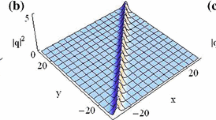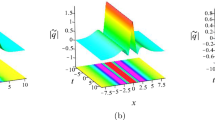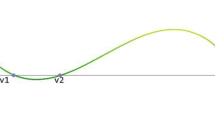Abstract
One-dimensional anisotropic Heisenberg ferromagnetic spin chain can be described by the fifth-order nonlinear Schrödinger equation, which is investigated in this paper. Through the Darboux transformation, we obtain the Akhmediev breathers (ABs), Kuznetsov–Ma (KM) solitons and rogue-wave solutions. Effects of the coefficients of the fourth-order dispersion, \(\gamma \), and of the fifth-order dispersion, \(\delta \), on the properties of ABs, KM solitons and rogue waves are discussed: (1) With \(\gamma \) increasing, the AB exhibits stronger localization in time; (2) The propagation directions of an AB and a KM soliton change with the presence of \(\delta \); and (3) Enhancement of \(\gamma \) makes the existence time of the rogue waves shorter, while enhancement of \(\delta \) increases the existence time of the rogue waves.
Similar content being viewed by others
Explore related subjects
Discover the latest articles, news and stories from top researchers in related subjects.Avoid common mistakes on your manuscript.
1 Introduction
Rogue waves are the large amplitude waves in the ocean which appear unexpectedly [1–3]. Notion of the rogue waves has been transferred into the realm of plasmas [4], Bose–Einstein condensation [5], Heisenberg ferromagnetic spin chain [6] and optical fibers [7]. The formation of rogue waves in nonlinear dispersive media can be described within the framework of nonlinear evolution equations, such as the nonlinear Schrödinger (NLS) equation [8–10, 13], which has the analytic solutions in the forms of certain types of breathers or solitons on the finite background, i.e., the Akhmediev breathers (ABs), Kuznetsov–Ma (KM) solitons and Peregrine solitons [8–12]. Such solutions allow the analytic studies into the conditions that support the emergence of rogue waves [8–12, 14, 15].
To describe the wave propagation more realistically, some models with the higher-order effects, such as the third- and fourth-order dispersion, self-steepening and symmetric perturbations, have been proposed [16, 17]. In this paper, via the Darboux transformation (DT) [18–21], we will investigate the analytic solutions in the forms of ABs, KM solitons and rogue waves of the fifth-order NLS equation as follows [22, 23]:

which works as a model corresponding to a one-dimensional anisotropic Heisenberg ferromagnetic spin chain, where \(q(x,t)\) represents the envelope of the waves, \(t\) and \(x\), respectively, denote the scaled time and spatial coordinates, the asterisk represents the complex conjugation, and the real parameters \(\alpha \), \(\gamma \) and \(\delta \) are, respectively, the coefficients of the third-order dispersion \(q_{xxx}\), fourth-order dispersion \(q_{xxxx}\) and fifth-order dispersion \(q_{xxxx}\) [22, 23]. Infinitely, many conversation laws and \(N\)-soliton solutions of Eq. (1) have been obtained [22]. Lax pair and soliton solutions of Eq. (1) have been derived [23].
Special cases of Eq. (1) have been used to describe different nonlinear waves, depending on the particular applicative context (e.g., Bose–Einstein condensation, plasma physics, nonlinear optics and Heisenberg ferromagnetic spin chain): (1) With \(\alpha =\gamma =\delta =0\), Eq. (1) can be reduced to the focusing NLS equation for the wave evolution in different physical systems [24, 26]; (2) when \(\alpha \ne 0\) and \(\gamma =\delta =0\), Eq. (1) can be reduced to the Hirota equation for the propagation of a subpicosecond or femtosecond pulse [10]; (3) for \(\alpha =\delta =0\) and \(\gamma \ne 0\), Eq. (1) can be reduced to a fourth-order dispersive NLS equation for the one-dimensional anisotropic Heisenberg ferromagnetic spin chain with the octuple–dipole interaction [27, 28]; and (4) with \(\alpha =\gamma =0\) and \(\delta \ne 0\), Eq. (1) can be reduced to a fifth-order NLS equation for the Heisenberg ferromagnetic spin system [22, 28]. Relevant issues can also be seen in [29–34].
However, to our knowledge, the breather and rogue-wave solutions of Eq. (1) have not been constructed through the DT. In Sect. 2, through the DT and limit process, the breathers and rogue-wave solutions of Eq. (1) will be derived. In Sect. 3, influence of \(\gamma \) and \(\delta \), the coefficients of the fourth-order dispersion and fifth-order dispersion, on the ABs, KM solitons and rogue waves will be discussed. Section 4 will be our conclusions.
2 Breather and rogue-wave solutions of Eq. (1) based on the DT
With the \(2\times 2\) Ablowitz–Kaup–Newell–Segur matrix [24, 25], the Lax pair associated with Eq. (1) can be given as [23]
where \(\varPsi =(\varPsi _{1}, \varPsi _{2})^{T}\) is the vector eigenfunction, \(\varPsi _{1}\) and \(\varPsi _{2}\) are the complex functions of \(x\) and \(t\), \(T\) denotes the transpose of the matrix, and \(\mathbf {U}\) and \(\mathbf {V}\) are expressible in the form of [23]
with
where \(\lambda \) is an eigenvalue of Lax Pair (2).
One can check that the compatibility condition \(\mathbf {U}_{t}-\mathbf {V}_{x}+\mathbf {UV}-\mathbf {VU}=0\) is equivalent to Eq. (1). Considering the gauge transformation,
through which we can cast Lax Pair (2) into
where \([j]\) \((j=0,1,2,\ldots N)\) represents the \(j\)th-iteration, \(N\) is a positive integer, \(\mathbf {D}[1]\) is a \(2\times 2\) matrix, \(\varPsi [1]\) is a \(2 \times 1\) vector eigenfunction, \(\mathbf {D}[1]^{-1}\) denotes the inverse matrix of \(\mathbf {D}[1]\), \(\mathbf {U}[1]\) and \(\mathbf {V}[1]\) are the \(2\times 2\) matrices.
Cross differentiation of Lax Pair (2) leads to
which implies that in order to keep Lax Pair (2) invariant under Transformation (4), we need to obtain a matrix \(\mathbf {D}\)[1] such that \(\mathbf {U}[1]\) and \(\mathbf {V}[1]\), respectively, possess the same forms as \(\mathbf {U}\) and \(\mathbf {V}\), while \(q\), which works as the old potential of the Lax-pair representation in \(\mathbf {U}\) and \(\mathbf {V}\), is mapped into the new one \(q[1]\) in \(\mathbf {U}[1]\) and \(\mathbf {V}[1]\).
Hereby, we assume the matrix \(\mathbf {D}[1]\) in the form of
where \(\lambda _{1}\) is an eigenvalue of Lax Pair (2), \(\varPsi _{1,1}\) and \(\varPsi _{2,1}\) are the complex functions of \(x\) and \(t\). It can be verified that if \((\varPsi _{1,1}, \varPsi _{2,1})^{T}\) is an eigenfunction of Lax Pair (2) with the eigenvalue \(\lambda =\lambda _{1}\), then \((-\varPsi ^{*}_{2,1}, \varPsi ^{*}_{1,1})^{T}\) is also an eigenfunction of Lax Pair (2) with the eigenvalue \(\lambda =\lambda ^{*}_{1}\).
Via Expressions (5), the DT for Eq. (1) is given by
To construct the breather and rogue-wave solutions of Eq. (1), we obtain the seed solutions first, as
The corresponding solutions for Lax Pair (2) at \(\lambda =i h\) are
where
Substituting Solutions (10) into DT (8), we obtain the breather solutions of Eq. (1) as follows:
where
Solutions (11) include the ABs \((0<h<1)\) and KM solitons \((1<h)\). When \(0 < h < 1\), the AB, which exhibits the localization in \(t\) but periodicity in \(x\), can be observed. When \(1<h\), the KM soliton appears. In contrast to the AB, the KM soliton is periodic in \(t\) and localized in \(x\). We note that \(|q|^2(0,0)=(1+2h)^2\), which is the height of peaks of breathers.
Then, we consider what will happen with respect to a breather when its period goes to the infinity. Based on Solutions (11) and setting \(h\rightarrow {1}\), we obtain the rogue-wave solutions of Eq. (1) as
where
The first-order rogue wave corresponds to a single wave with localization in \(t\) and \(x\). The peak height of that rogue wave is \(|q|^2(0,0)=9\). Effects of \(\gamma \) and \(\delta \) on the properties of ABs, KM solitons and rogue waves will be discussed in Sect. 3.
Let \((\varPsi _{1,1}, \varPsi _{2,1})^{T}\), \((\varPsi _{1,2}, \varPsi _{2,2})^{T}\),\(\ldots \), \((\varPsi _{1,N}, \varPsi _{2,N})^{T}\) be the \(N\) distinct solutions of Lax Pair (2) at \(\lambda _{1},\ldots , \lambda _{N}\), respectively, where \({\varPsi _{1,k}}\)’s and \({\varPsi _{2,k}}\)’s \((k=1,2,\ldots ,N)\) are the functions of \(x\) and \(t\), and \(\lambda _{k}\)’s are the eigenvalues of Lax Pair (2). Via the \(N\) iteration of Expression (4) and (5), the \(N\)-fold DT for Eq. (1) is
with
When \(N=2\), the \(2\)-fold DT can be expressed as
Since all the eigenvalues in the standard Darboux scheme are the same, the explicit formulas for \(\varPsi _{1,2}[1]\) and \(\varPsi _{2,2}[1]\) cannot be obtained from the scheme. Instead, to obtain the second-order rogue-wave solutions of Eq. (1), we solve Lax Pair (2) with the \(q\) function found at the previous step, \(q=q[1]\), to obtain \(\varPsi _{1,2}[1]\) and \(\varPsi _{2,2}[1]\),
with
By virtue of Expressions (15) and (16), we obtain the second-order rogue-wave solutions of Eq. (1) as
where \(G_{2}\) and \(F_{2}\) are given in the Appendix.
3 Discussions
Figure 1 shows the propagation of an AB and a KM soliton without the presence of \(\gamma \) and \(\delta \). In the case \(\gamma \ne 0\) and \(\delta =0\), the propagation of ABs and KM solitons is shown in Figs. 2 and 3: As \(\gamma \) increases, the AB exhibits stronger localization in \(t\), while the distance between adjacent peaks keeps unchanged with \(\gamma \) increasing, as seen in Fig. 2; for the KM soliton, as \(\gamma \) increases, the distance between adjacent peaks decreases, as seen in Fig. 3. In the case \(\gamma =0\) and \(\delta \ne 0\), the propagation of an AB and a KM soliton is displayed in Fig. 4. We note that the propagation directions of the AB and KM soliton change with the presence of \(\delta \).
Breathers via Solutions (11) with \(\alpha =0.01\), \(\delta =0\), \(\gamma =0\), a \(h=0.2\) (the AB) b \(h=1.2\) (the KM soliton)
The ABs via Solutions (11) with \(\alpha =0.01\), \(\delta =0\), \(h=0.2\) a \(\gamma =0.5\) and b \(\gamma =1\)
The KM solitons via Solutions (11) with \(\alpha =0.01\), \(\delta =0\), \(h=1.2\) a \(\gamma =0.02\) and b \(\gamma =0.08\)
Breathers via Solutions (11) with \(\alpha =0.01\), \(\delta =0.03\), \(\gamma =0\), a \(h=0.2\) (the AB) b \(h=1.2\) (the KM soliton)
Here, we investigate how \(\gamma \) and \(\delta \) affect the properties of rogue waves. With the presence of \(\gamma \) and \(\delta \), one case of the first-order rogue-wave solutions is shown in Fig. 5. With the increase in \(\gamma \), properties of the first-order rogue waves can be shown in Fig. 6a. In Fig. 6b, it is found that the rogue wave can reach its peak and disappear more quickly with the increase in \(\gamma \) at \(x=0\). In other words, increasing the value of \(\gamma \) makes the existence time of a first-order rogue wave shorter. We note that \(t=0\) implies that \(q(x,t)=\frac{-3+4x^2}{1+4x^2}\), which means that \(\gamma \) and \(\delta \) do not influence the envelope of the waves \(q(x,t)\). With the comparison between Figs. 5 and 7, we find that increasing \(\delta \) would lead to an increase in the existence time of a first-order rogue wave. Increasing the value of \(\gamma \) makes the existence time of a second-order rogue wave shorter, while increasing \(\delta \) would lead to an increase in the existence time of a second-order rogue wave. For simplicity, we do not include the figures here.
The first-order rogue wave via Solutions (12) with \(\alpha =0.01\), \(\gamma =0.01\) and \(\delta =0.01\)
The same as Fig. 5 except that \(\delta =0.05\)
4 Conclusions
The ABs, KM solitons and rogue waves of the fifth-order NLS equation, i.e., Eq. (1), which works as a model corresponding to a one-dimensional anisotropic Heisenberg ferromagnetic spin chain, have been investigated. Through DT (8), the ABs, KM solitons and rogue-wave solutions, i.e., Solutions (11), (12) and (17), have been obtained. Dependence of the properties of the ABs, KM solitons and rogue waves on the coefficients of the fourth-order dispersion, \(\gamma \), and of the fifth-order dispersion, \(\delta \), has been examined. Figure 1 has shown the propagation of an AB and a KM soliton without the presence of \(\gamma \) and \(\delta \). In the case \(\gamma \ne 0\) and \(\delta =0\): As \(\gamma \) increases, the AB exhibits stronger localization in time, while the distance between the adjacent peaks keeps a unchanged with \(\gamma \) increasing, as seen in Fig. 2; for a KM soliton, as \(\gamma \) increases, the distance between the adjacent peaks decreases, as seen in Fig. 3. The propagation directions of an AB and a KM soliton change with the presence of \(\delta \), as shown in Fig. 4. Figure 5 has displayed the first-order rogue wave with the presence of \(\gamma \) and \(\delta \). Figure 6 has shown that the enhancement of \(\gamma \) makes the existence time of the first-order rogue wave shorter. With the comparison between Figs. 5 and 7, we have found that the enhancement of \(\delta \) increases the existence time of the first-order rogue wave.
References
Kharif, C., Pelinovsky, E., Slunyaev, A.: Rogue Waves in the Ocean. Springer, Heidelberg (2009)
Dysthe, K., Krogstad, H.E., Müller, P.: Oceanic rogue waves. Ann. Rev. Fluid Mech. 40, 287–310 (2008)
Osborne, A.R.: Nonlinear Ocean Waves. Acad., New York (2009)
Stenflo, L., Shukla, P.K.: Nonlinear acoustic-gravity waves. J. Plasma Phys. 75, 841–847 (2009)
Bludov, Y.V., Konotop, V.V., Akhmediev, N.: Matter rogue waves. Phys. Rev. A 80, 033610 (2009)
Ankiewicz, A., Wang, Y., Wabnitz, S., Akhmediev, N.: Extended nonlinear Schrödinger equation with higher-order odd and even terms and its rogue wave solutions. Phys. Rev. E 89, 012907 (2014)
Solli, D.R., Ropers, C., Koonath, P., Jalali, B.: Optical rogue waves. Nature 450, 1054–1057 (2007)
Dudley, J.M., Dias, F., Erkintalo, M., Genty, G.: Instabilities, breathers and rogue waves in optics. Nat. Photon. 8, 755–764 (2014)
Akhmediev, N., Ankiewicz, A., Soto-Crespo, J.M.: Rogue waves and rational solutions of the nonlinear Schrödinger equation. Phys. Rev. E 80, 026601 (2009)
Akhmediev, N., Soto-Crespo, J.M., Ankiewicz, A.: Rogue waves and rational solutions of the Hirota equation. Phys. Rev. E 81, 046602 (2010)
Akhmediev, N., Ankiewicz, A., Taki, M.: Waves that appear from nowhere and disappear without a trace. Phys. Lett. A 373, 675–678 (2009)
Peregrine, D.H.: Water waves, nonlinear Schrödinger equations and their solutions. J. Aust. Math. Soc. B 25, 16–43 (1983)
Lü, X., Peng, M.: Nonautonomous motion study on accelerated and decelerated solitons for the variable-coefficient Lenells–Fokas model. Chaos 23, 013122 (2013)
Zhu, H.P.: Nonlinear tunneling for controllable rogue waves in two dimensional graded-index waveguides. Nonlinear Dyn. 72, 873–882 (2013)
Dai, C.Q., Wang, Y.Y., Tian, Q., Zhang, J.F.: The management and containment of self-similar rogue waves in the inhomogeneous nonlinear Schrödinger equation. Ann. Phys. 327, 512–521 (2012)
Akhmediev, N., Ankiewicz, A.: Solitons, Nonlinear Pulses and Beams. London (1997)
Ankiewicz, A., Chowdhury, A., Devine, N., Akhmediev, N.: Rogue waves of the nonlinear Schrödinger equation with even symmetric perturbations. J. Opt. 15, 064007 (2013)
Guo, B., Ling, L., Liu, Q.P.: Nonlinear Schrödinger equation: generalized Darboux transformation and rogue wave solutions. Phys. Rev. E 85, 026607 (2012)
Zuo, D.W., Gao, Y.T., Feng, Y.J., Xue, L.: Rogue-wave interaction for a higher-order nonlinear Schrödinger–Maxwell–Bloch system in the optical-fiber communication. Nonlinear Dyn. 78, 2309–2318 (2014)
Matveev, V.B., Salle, M.A.: Darboux Transformation and Solitons. Springer, Berlin (1991)
Lü, X.: Soliton behavior for a generalized mixed nonlinear Schrödinger model with \(N\)-fold Darboux transformation. Chaos 23, 033137 (2013)
Wang, P.: Conservation laws and solitons for a generalized inhomogeneous fifth-order nonlinear Schrödinger equation from the inhomogeneous Heisenberg ferromagnetic spin system. Eur. Phys. J. D 68, 1–8 (2014)
Chowdury, A., Kedziora, D.J., Ankiewicz, A., Akhmediev, N.: Soliton solutions of an integrable nonlinear Schrödinger equation with quintic terms. Phys. Rev. E 90, 032922 (2014)
Ablowitz, M.J.: Nonlinear Dispersive Waves. Cambridge Univ. Press, Cambridge (2011)
Lü, X., Peng, M.: Systematic construction of infinitely many conservation laws for certain nonlinear evolution equations in mathematical physics. Commun. Nonlinear Sci. Numer. Simul. 18, 2304–2312 (2013)
Pisarchik, A.N., Jaimes-Reategui, R., Sevilla-Escoboza, R., Huerta Cuellar, G.: Rogue waves in a multistable system. Phys. Rev. Lett. 107, 274101 (2011)
Lakshmanan, M., Porsezian, K., Daniel, M.: Effect of discreteness on the continuum limit of the Heisenberg spin chain. Phys. Lett. A 133, 483–488 (1988)
Radha, R., Kumar, V.R.: Explode-decay solitons in the generalized inhomogeneous higher-order nonlinear Schrödinger equations. Z. Naturforsch. A 62, 381–386 (2007)
Sun, Z.Y., Gao, Y.T., Yu, X., Liu, Y.: Dynamics of bound vector solitons induced by stochastic perturbations: Soliton breakup and soliton switching. Phys. Lett. A 377, 3283–3290 (2013)
Sun, Z.Y., Gao, Y.T., Yu, X., Liu, Y.: Amplification of nonautonomous solitons in the Bose-Einstein condensates and nonlinear optics. Europhys. Lett. 93, 40004 (2011)
Sun, Z.Y., Gao, Y.T., Liu, Y., Yu, X.: Soliton management for a variable-coefficient modified Korteweg-de Vries equation. Phys. Rev. E 84, 026606 (2011)
Zuo, D.W., Gao, Y.T., Xue, L., Feng, Y.J., Sun, Y.H.: Rogue waves for the generalized nonlinear Schrodinger–Maxwell–Bloch system in optical-fiber communication. Appl. Math. Lett. 40, 78–83 (2015)
Shen, Y.J., Gao, Y.T., Zuo, D.W., Sun, Y.H., Feng, Y.J., Xue, L.: Nonautonomous matter waves in a spin-1 Bose-Einstein condensate. Phys. Rev. E 89, 062915 (2014)
Shen, Y.J., Gao, Y.T., Yu, X., Meng, G.Q., Qin, Y.: Bell-polynomial approach applied to the seventh-order Sawada-Kotera-Ito equation. Appl. Math. Comput. 227, 502–508 (2014)
Acknowledgments
This work has been supported by the National Natural Science Foundation of China under Grant No. 11272023, by the Open Fund of State Key Laboratory of Information Photonics and Optical Communications (Beijing University of Posts and Telecommunications) under Grant No. IPOC2013B008, and by the Fundamental Research Funds for the Central Universities of China under Grant No. 2011BUPTYB02.
Author information
Authors and Affiliations
Corresponding author
Appendix
Appendix
Rights and permissions
About this article
Cite this article
Sun, WR., Tian, B., Zhen, HL. et al. Breathers and rogue waves of the fifth-order nonlinear Schrödinger equation in the Heisenberg ferromagnetic spin chain. Nonlinear Dyn 81, 725–732 (2015). https://doi.org/10.1007/s11071-015-2022-4
Received:
Accepted:
Published:
Issue Date:
DOI: https://doi.org/10.1007/s11071-015-2022-4











